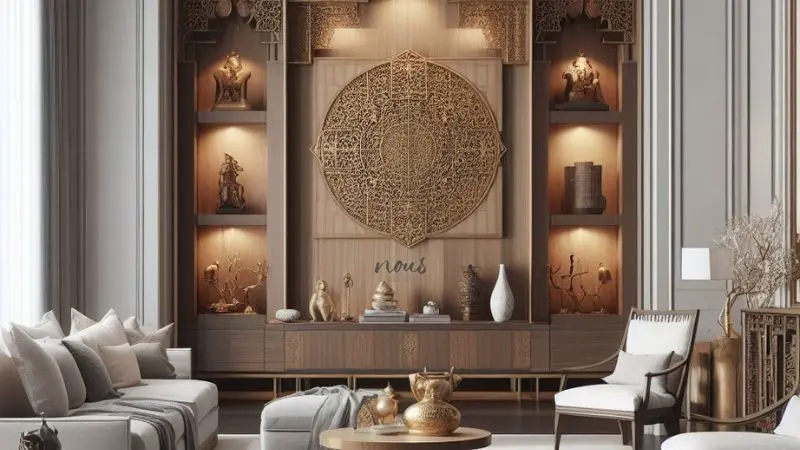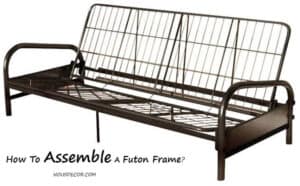When it comes to interior design, conventional furniture continues to be a well-known choice for many homeowners. These classic furniture usually made from dark-colored woods, harken back to the 18th- and 19th-century European and American furniture designs, and are characterized by their elaborate detailing and timeless grace.
In contrast to the sharp angles and minimalist designs of the modernist movement, conventional furniture is known for their curved lines, intricate carvings, and luxurious fabrics. The Jacobean era, for example, brought us furniture with intricate carving and robust structure which continues to be a part of conventional furniture.
Conventional furniture are commonly found in living and dining rooms where they often provide elegant living room seating and dining area furniture. They are a common choice for those seeking to create a warm and inviting atmosphere in their homes.
Throughout the 19th and early 20th centuries, conventional furniture evolved and adapted to changing trends in interior design, but they have always maintained their common characteristics. Today, conventional furniture styles continue to be a reputable choice for those looking to add a touch of timeless grace to their homes. Whether it’s a classic Victorian sofa or an elaborate dining table, conventional furniture styles are a versatile and enduring option for any home.
In this Neusdecor article, we will answer the question “What Is Traditional Furniture Styles” and learn more about this unique style.
Takeaways
- Traditional Furniture Styles encompass a diverse array of design aesthetics and historical influences.
- These styles exhibit distinctive characteristics from the elaborate and elaborate designs of Victorian Furniture to the streamlined and geometric elements embodied by Art Deco Furniture.
- Each sub-style represents an object of admiration for its unique attributes, like the early American design aesthetics represented in Colonial Furniture, showcasing its influence on modern rustic décor.
- Moreover, the intricate woodworking techniques showcased by Chippendale Furniture underscore its lasting impact on traditional craftsmanship.
- Within the realm of conventional furniture, the reflection of rustic grace and simplicity found in French Provincial Furniture has left a significant mark, influencing trends like the shabby chic design movement.
- Thus, understanding conventional furniture styles involves exploring these diverse sub-styles as interconnected elements within a broader framework of design history and cultural significance.
What Is Traditional Furniture Styles?
Conventional furniture styles encompass a wide range of design influences and aesthetic choices, including traditional Indian furniture and traditional interior decor. This type of furniture is often characterized by its classic and timeless appeal, and it is typically crafted using high-quality materials, such as cherry wood, to ensure durability. Conventional furniture is also distinct from contemporary furniture style, as it often evokes a sense of history and nostalgia.
They are commonly used in interior decorating to create a warm and inviting atmosphere, and they may be combined with modern classic or transitional furniture to achieve a more eclectic look. Additionally, conventional furniture may also encompass revival furniture, which seeks to reproduce historical designs, as well as abstract pieces that interpret traditional forms in a modern context.
Ultimately, conventional furniture offers a wealth of options for those who appreciate the grace and sophistication of classic designs.
Some of The Popular Traditional Styles For Furniture
Conventional styles are often characterized by their classic and timeless designs, reflecting different cultural and historical influences.
- Queen Anne: Originating in the early 18th century in England, it is characterized by its graceful curves, cabriole legs, and pad feet, and often features intricate carving and a mix of walnut, cherry, and maple woods. This graceful and refined style is known for its emphasis on comfort and sophistication.
- Pennsylvania Dutch: Originating in the late 17th century in Pennsylvania by German immigrants, it is recognized for its sturdy craftsmanship, decorative folk art motifs like tulips, hearts, and birds, and the use of regional woods such as oak, cherry, and pine. This style reflects a fusion of Germanic traditions with American influence, featuring distinctive hand-painted designs and functional, practical forms.
- Louis XVI: The Louis XVI furniture style emerged in 18th-century France during the reign of King Louis XVI and is characterized by its neoclassical influences, straight lines, symmetry, delicate details like fluting, floral motifs, and the use of luxurious materials like mahogany, marble, and gilt bronze. This style represents a shift from the opulence of the preceding Rococo period to a more refined, geometric elegance inspired by ancient Roman and Greek designs.
- Chippendale: This furniture style, originating in 18th-century England, is distinguished by its intricate craftsmanship, intricate carvings, cabriole legs, ball-and-claw feet, and a blend of Gothic, Chinese, and Rococo influences. Named after the cabinetmaker Thomas Chippendale, this style showcased a wide range of designs from elaborately detailed pieces to simpler, more geometric forms, reflecting both opulence and practicality.
These conventional styles are often paired with complementary furniture and accessories, creating a cohesive and harmonious look in any room. Whether found in vintage furniture shops or modern furniture stores, these styles have stood the test of time, successfully merging traditional and contemporary design with the rich history of traditional furniture. As a result, these styles of furniture have emerged as timeless and versatile choices for both furniture and decor, adding charm and character to any new traditional room.

Traditional Furniture Characteristics
Conventional furniture is defined by several key characteristics that have endured through the ages. It is important to understand the history of this interior design style in order to appreciate the complete guide of its design and style. The characteristics of conventional furniture include elaborate details, rich materials such as wood, classic silhouettes, formal upholstery, dark finishes, and timeless appeal.
These features can be seen in the clean lines and intricate carvings of traditional wood furniture, which emerged in the 17th and 18th centuries as a result of European influence. The elaborate details and rich materials of conventional furniture reflect a sense of luxury and sophistication, while the classic silhouettes and formal padding add grace and formality to any space. The dark finishes of conventional furniture contribute to its timeless appeal, making it a well-known choice for those who appreciate classic and elegant design.
Dark Wood Tones
Traditional furniture with dark wood often features characteristic elements such as cabriole legs, which add a sense of grace and sophistication to the piece. Anne style and Chippendale style are also commonly associated with dark-colored wood, with intricate carving and elaborate detailing.
Bel furniture, which often originates from Chinese furniture, is also known for its use of dark-colored wood and intricate designs. The deep, rich hues of the wood from Anne furniture lend a sense of warmth and timelessness to conventional furnishing, making it a great choice for those seeking a classic and timeless aesthetic for their home.
Rich Color Palette
Traditional furniture is characterized by its rich color, which sets it apart from the more modern, contemporary style. Customers who appreciate conventional furnishing often value high-quality customer service and a wide delivery area that allows them to access pieces from all over.
In terms of design, traditional furniture is commonly seen in modern traditional interior design, which combines classic elements with a modern twist. The rich color often includes deep, warm tones, as well as neutral colors to create an inviting and timeless atmosphere. Straight lines are also a common feature, adding a sense of sophistication and grace to the overall look.
Ornate Woodwork
Traditional style furniture is known for its elaborate woodwork, with soft edges and intricate detailing. The Pennsylvania Dutch are particularly recognized for their traditional furniture, which often incorporates elaborate carvings and craftsmanship.
This style of furniture emerged in the 18th century and has since remained a classic choice for many homeowners. The elaborate woodwork on traditional furniture adds a touch of grace and sophistication to any space, making it a timeless and enduring choice. Classic pieces such as armoires, dining tables, and bed frames often showcase the beautiful and intricate woodwork that is synonymous with traditional furniture.
Luxe Fabrics
Traditional furniture characteristics often include luxe fabrics that exude grace and sophistication. From luxurious silk to rich velvet, traditional furniture pieces are often adorned with these opulent materials to create a sense of luxury and comfort.
In a traditional living area, you can expect to see a variety of luxe fabrics on different furniture styles, such as intricately upholstered sofas and couches, plush armchairs, and elaborate ottomans. These fabrics are often in line with various design styles that fall under the traditional umbrella, such as classic style, European-inspired designs, and timeless aesthetics that prioritize quality and craftsmanship. Overall, luxe fabrics are a key part of traditional furniture, adding a touch of glamour and refinement to any space.
Gold Accents
In traditional furniture, gold accents add a touch of luxury and grace to the overall design. Whether it’s in a mid-century modern piece with gold trim or a classic style with intricate gold crown molding, these prominences elevate the aesthetic of the furniture.
Claw feet with gold detailing are also a common feature, adding a regal and timeless feel. These characteristics contribute to the classic and traditional style often associated with interior design, creating a sense of opulence and sophistication. Whether it’s a delicate gold detail on a chair or a bold gold fixture on a table, these accents enhance the overall look and feel of traditional furniture.
Intricate Upholstery
Intricate upholstery in conventional furniture is a must-have choice for any home, particularly those with a classic and traditional design. This type of padding often features intricate patterns, luxurious fabrics, and detailed craftsmanship, adding an air of sophistication and refinement to any room.
The beauty of formal padding is that it can be tailored to suit any style or preference, with a wide range of fabrics, colors, and patterns available to choose from. Whether it’s a classic floral pattern, a rich velvet fabric, or a timeless plaid design, there are endless options to match the zip code and design of a traditional home. Overall, formal padding in conventional furniture is a tasteful and luxurious choice, adding an element of refinement and grace to any space.
Curved Silhouettes
Traditional furniture features curved silhouettes, adding a touch of grace and sophistication to any traditional living room or space. This characteristic is commonly found in traditional style furniture, which is known for its ornate detailing and timeless appeal.
Whether it’s a classic rolled-arm sofa or a gracefully arched headboard, curved silhouettes bring a sense of softness and fluidity to traditional decor. These pieces often evoke a sense of history and tradition, making them perfect for creating a warm and welcoming atmosphere in traditional living rooms. The use of curved silhouettes in traditional furniture helps to create a sense of comfort and familiarity, making them a decent choice for many homeowners.
Architectural Design Elements
Traditional furniture embodies architectural design such as intricate carvings, elaborate moldings, and attention to detail. These pieces are typically made from high-quality, solid wood and feature classic and timeless forms. Traditional furniture often incorporates elements inspired by historical periods such as the Renaissance, Baroque, or Victorian eras, with an emphasis on graceful curves, symmetrical shapes, and elaborate decorative embellishments.
This type of furniture is known for its craftsmanship and durability, with an emphasis on creating timeless pieces that can be passed down through generations. The architectural elements present in traditional furniture contribute to its timeless and elegant aesthetic, making it a valuable choice for those seeking a sense of history and sophistication in their home decor.
Comparing Modern Furniture Style & Traditional Style
When it comes to the difference between modern and traditional styles, there are several key differences to consider.
- In terms of couches, modern living room furniture tends to have sleek, neat lines and often incorporates materials like glass and metal, while traditional styles may feature more elaborate detailing and plush, upholstered fabrics.
- The kitchen is also a notable area of difference, with modern kitchens often featuring minimalist design and sleek surfaces, while traditional kitchens may have more elaborate cabinetry and decorative touches.
- When it comes to the office, present-day furniture may feature open, streamlined workspaces, while traditional styles may incorporate more elaborate desks and bookcases.
- In terms of specific design movements, mid century modern is known for its retro, yet timeless appeal, while organic modern emphasizes the use of natural materials and relaxed, organic forms.
Ultimately, both styles have their own pros and cons, with present-day furniture being seen as trendy and ultra modern, while traditional furniture is often valued for its rustic, timeless charm.
Below is a simplified table for the advantages and drawbacks of each furnishing style
| Aspect | Modern Style | Conventional Style |
|---|---|---|
| Pros | Embraces minimalism and neat lines, offering a sleek and uncluttered look. | Celebrates heritage, offering a timeless and elegant appeal. |
| Utilizes innovative materials for a futuristic aesthetic. | Showcases rich materials and craftsmanship. | |
| Prioritizes functionality and usability in design. | Features elaborate details and luxurious padding. | |
| Often fits well in contemporary, urban, or minimalist spaces. | Adds a sense of history and classic charm to interiors. | |
| Cons | May feel too stark or cold for those seeking warmth or coziness. | Can appear overly formal or elaborate for some tastes. |
| Designs might not suit traditional or historical-themed interiors. | May require more space due to its larger, more elaborate pieces. | |
| Trends might date quickly due to their contemporary nature. | Could feel outdated if not incorporated thoughtfully. |
At the end of the day, the choice between modern and traditional styles ultimately comes down to personal preference and the specific aesthetic and functional needs of each individual or space.

Is Traditional Furniture Out of Style?
The cyclical nature of design trends means that what is considered out of style today may very well come back into fashion tomorrow. Traditional furniture with its classic lines and elaborate detailing may have fallen slightly out of favor in recent years, but there has been a resurgence of interest in giving traditional pieces a modern twist.
By incorporating sleek, modern materials and geometric shapes into traditional designs, these items can once again become a focal point in any room. As more and more people seek to balance the sleekness of modern design with the warmth and familiarity of traditional styles, there is no doubt that traditional furniture is making a comeback. Many retailers are even offering free shipping on traditional items, making it easier than ever for consumers to incorporate these timeless pieces into their homes.
Ultimately, the short answer to the question of whether traditional furniture is out of style is no. In fact, it can be a great way to blend old and new design ideas and create a unique and personalized home aesthetic.
Reasons Why Traditional Furniture Remains Popular
Traditional furniture remains popular for a variety of reasons, despite the rise of modern and minimalist design trends in the post industrial era.
- Timeless aesthetics: Traditional designs often feature classic and timeless styles that have been passed down through generations. Whether it’s the elaborate carvings of a Victorian settee or the elegant curves of a Queen Anne chair, traditional furniture has a certain charm that never goes out of style.
- Heritage and history: Many pieces have a rich history and cultural significance, making them highly sought after by collectors and interior design enthusiasts. Whether it’s a classic French provincial armoire or a sturdy Amish-made dining table, traditional furniture carries a sense of nostalgia and sentimentality that adds to its appeal.
- Versatility and adaptability: While present-day furniture may be designed to fit into a specific aesthetic or space, many pieces of furniture are often more versatile and can be easily integrated into a variety of design. For example, a timeless set of Windsor dining chairs can work just as well in a modern farmhouse as they do in a classic country kitchen.
- Perceived quality and durability: Many traditional furniture are constructed from high-quality materials such as solid wood, leather, and metal, making them durable and long-lasting. This perceived quality and craftsmanship add to the appeal of traditional furniture, as consumers value items that they believe will last for a long time.
- Emotional value and comfort: Most traditional furniture evokes a sense of comfort and nostalgia, as they are often associated with cozy and inviting interiors. Whether it’s sinking into a plush wingback chair or curling up on a deep-buttoned Chesterfield sofa, traditional furniture provides a sense of emotional comfort and security.
- Status and formality: Traditional furniture has long been associated with grace, sophistication, and formality, making it a popular choice for formal living rooms, dining area, and other formal spaces.
Whether it’s a stately mahogany desk or a grand oak dining table, traditional furniture conveys a sense of status and prestige, making them highly desirable for those who value traditional and formal aesthetics.
How To Incorporate Traditional Furniture in a Modern Space
Incorporating traditional furniture in a modern space can create a unique and stylish look that combines the best of both worlds. When mixing styles, it’s important to do so thoughtfully.
- Start by identifying the key elements of your modern space and look for traditional furniture that complements those elements. Consider the scale and proportion of the traditional furniture in relation to the modern pieces in the room. It’s essential that the traditional pieces don’t overpower the space or seem out of place.
- In terms of color palette and materials, try to find traditional furniture that complements the colors and materials already present in the modern space. This could mean incorporating wood or leather furniture to add warmth and depth to a room filled with sleek, metallic accents.
- When incorporating traditional furniture in a modern space, attention to detail is crucial. Focus on incorporating timeless details such as intricate carvings, moldings, or hardware that will complement the modern aesthetic without feeling out of place.
- Layering textures and accessories can also help blend traditional and modern layout seamlessly. Add pillows, throws, and rugs with traditional patterns and textures to soften the clean lines of present-day furniture. And finally, don’t be afraid to experiment and personalize.
- Mix and match different styles and eras to create a space that feels unique and reflective of your personal taste. Blend modern art with traditional furniture, or mix and match different wood finishes to add depth and character to your space.
In conclusion, incorporating traditional furniture in a modern space is all about balance and harmony. Mixing styles thoughtfully, considering scale and proportion, and paying attention to color palettes, materials, and details are all key elements in creating a successful fusion of traditional and modern layout. Layering textures and accessories, and allowing yourself to experiment and personalize your space will also add the finishing touches to create a space that feels cohesive and inviting. So, don’t be afraid to add a touch of tradition to your modern space – it could be just the thing to give it a timeless and elegant feel.

What Is Traditional Furniture Styles Bedroom?
When it comes to traditional bedroom furniture styles, there is a timeless appeal that can create a classic and elegant bedroom interior. Traditional bedroom decor often features rich wood finishes, intricate details, and elaborate designs that add a sense of luxury and sophistication to the space. One of the most popular traditional bedroom sets is the Italian bedroom, which is known for its intricate carvings, luxurious fabrics, and rich colors.
Some of the well-known traditional bedroom furniture include:
- Ornate bed frames is a decorative and intricately designed bed frame often featuring elaborate carvings, scrolls, or detailing. Having a traditional elaborate bed frame in your bedroom adds a touch of timeless grace and sophistication, transforming the room into a luxurious and visually captivating space, and elevating the overall ambiance and style.
- Elegant headboards and footboards often feature intricate detailing or luxurious fabrics. Having traditional elegant headboards and footboards in your bedroom enhances the room’s aesthetic appeal, imbuing it with a sense of refinement and sophistication while serving as focal points that elevate the overall grace of the space.
- Classic wooden dressers are wooden furniture adorned with timeless designs, carvings, and durable craftsmanship. Having a traditional classic wooden dresser and footboard in your bedroom adds a sense of heritage and grace to the room while enhancing the space with their enduring beauty and craftsmanship.
- A nightstand is a small bedside table typically crafted with classic designs and sturdy materials. Having a traditional nightstand in your bedroom provides a convenient surface to keep essentials within reach, adding a touch of timeless grace to your sleeping space while offering functional utility.
- Intricately designed armoires or wardrobes are sizable storage furniture featuring elaborate carvings, detailing, and often rich woodwork. Having a traditional armoire or wardrobe in your bedroom not only offers ample storage for clothes and linens but also serves as a stunning focal point, adding a touch of classic grace and sophistication to the home décor.
How to Create a Traditional Bedroom Style
To create a traditional bedroom style, start by selecting a color theme of rich, warm tones such as deep browns, reds, and golds.
- Choose furniture with elaborate detailing, such as intricate carvings or decorative hardware, to add a sense of opulence to the space.
- Incorporate luxurious fabrics such as satin for bedding, curtains, and padding to add a touch of grace. Traditional bedroom decor often includes decorative prominences such as antique-looking lamps, elaborate mirrors, and classic artwork to tie the room together.
- To complete the traditional bedroom look, consider adding in traditional patterns such as damask or floral prints for a touch of old-world charm.
By carefully selecting traditional bedroom furniture pieces and incorporating rich colors and luxurious fabrics, you can create a timeless and elegant traditional bedroom style that exudes luxury and sophistication.
Frequently Asked Questions
Conclusion
In conclusion, conventional styles have deeply rooted historical influences that continue to be prominent in interior design today. Upholstered furniture, often with intricate patterns and textures, remains a staple in traditional furniture.
The furniture today often features turned legs, rich wood tones, and elaborate detailing that emerged in the 18th and 19th centuries. Traditional dining room furniture showcases this style, combining grace with practicality. Contemporary traditional furniture incorporates transitional style features, merging the old with the new. Traditional furniture combines style and color in ways that are timeless and classic, making it a versatile option for many interior design trends.
While traditional furniture may not be the most modern option, it still holds a place in today’s interior design landscape, including traditional features in many contemporary homes. The enduring appeal of conventional styles speaks to the timeless elements they offer, making it a good choice for those seeking to incorporate a sense of history and heritage into their living spaces.






